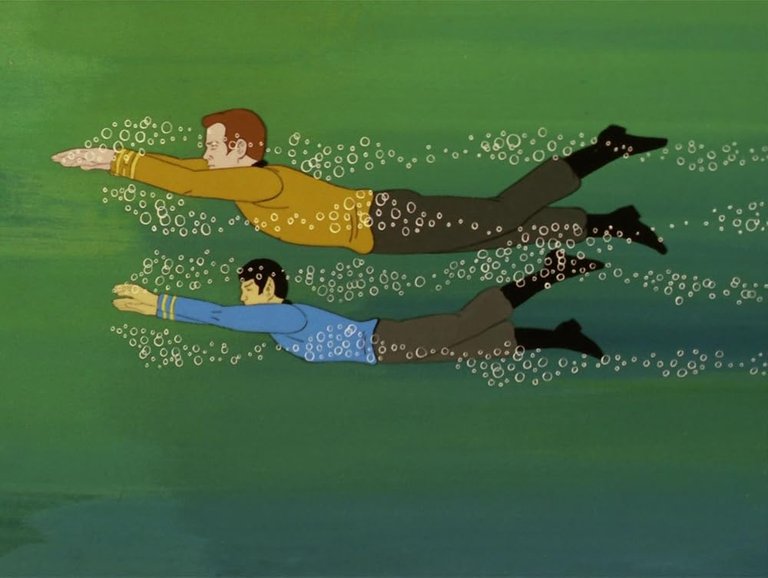Television Review: The Ambergris Element (Star Trek: The Animated Series, S1X13, 1973)

The Ambergris Element (S01E13)
Airdate: December 1st 1973
Written by: Margaret Armen
Directed by: Hal Sutherland
Running Time: 22 minutes
The Star Trek: Animated Series stands apart from its live-action predecessors not merely as a lesser cousin but as a bold experiment in visual storytelling, leveraging animation to explore worlds and concepts that would have been prohibitively expensive or technically impossible to depict on film. Few episodes exemplify this potential as strikingly as The Ambergris Element, a 1973 instalment that plunges the Enterprise crew into a submerged planet teeming with bioluminescent depths, ancient aquatic civilisations, and ecological peril. This episode’s audacity to abandon the confines of practical effects and embrace the limitless possibilities of animation is its greatest strength, making it one of the Animated Series’ most inventive and underappreciated chapters.
The plot unfolds as the Enterprise arrives at the planet Argo, now a water-world following a series of catastrophic geological upheavals. Captain Kirk, Spock, Dr. McCoy, and Lieutenant Clayton descend in a deep-water shuttle to investigate, only for their craft to be mauled by a colossal sea serpent. The damaged shuttle forces an emergency evacuation, but while McCoy and Clayton are beamed to safety, Kirk and Spock vanish. A rescue party later discovers them grotesquely altered by surgical additions: gills, webbed hands, and other aquatic adaptations. The duo’s memory of the transformation is hazy, and Kirk—now desperate to reclaim command—insists on returning to Argo to undo the changes. Their quest leads them to the Aquans, an enigmatic humanoid species confined to the ocean depths. The Aquans are fractured by generational strife: the elder leaders distrust surface-dwellers, viewing them as invaders who drove their ancestors underground millennia ago, while the younger generation, led by the idealistic Rila, yearn to reclaim the skies. The resolution hinges on a rare sea serpent venom capable of reversing the mutations, culminating in the Enterprise aiding the Aquans in escaping a cataclysmic earthquake that threatens to destroy their world.
Written by Margaret Armen, a veteran of The Original Series (her TOS credits include The Gamesters of Triskelion and The Paradise Syndrome), The Ambergris Element revels in the animation medium’s capacity to visualise the impossible. The episode’s premise—a planet entirely submerged by water—could scarcely have been executed in live action without resorting to hokey special effects. Here, however, Argo becomes a mesmerising, otherworldly realm.The sea serpent attack alone is a masterstroke, its serpentine form coiling around the shuttle with a menace that live-action might have diluted through practical limitations. The Aquans, too, are a refreshing departure from Star Trek’s usual template of advanced, spacefaring aliens. Their lack of technological prowess—reliant on ancient ruins and oral histories—grounds them in primal humanity, contrasting starkly with the Enterprise’s gleaming futurism. The generational conflict among the Aquans, echoing late 1960s societal divides between older and younger generations, adds thematic depth.
Yet for all its ambition, the episode occasionally stumbles under its own weight. Clocking in at just 22 minutes, it packs an overstuffed narrative that strains to balance character arcs, worldbuilding, and action. The Aquans’ society, while intriguingly layered, feels underexplored: their history of displacement, the origins of their mutation technology, and the full extent of the planet’s ecological collapse are sketched in broad strokes, leaving viewers to infer details rather than absorb them. Similarly, Kirk and Spock’s transformation is resolved abruptly, with the venom’s efficacy explained through exposition rather than earned through the characters’ ingenuity. The rushed pacing forces key moments into a frenzy of cutaways and voiceover, sacrificing emotional resonance for plot momentum. Even the animation, while vibrant, occasionally betrays its low-budget origins, particularly in the Aquans’ designs, which lack the consistency or detail of the Enterprise’s more polished visuals.
Nonetheless, the episode compensates for its structural flaws with relentless energy and visual spectacle. The constant shifts between the claustrophobic confines of the Enterprise’s medical bay, the Aquans’ submerged cities, and the planet’s churning depths keep the narrative from stagnating
Had The Ambergris Element been granted the extended runtime of a TOS episode (typically around 48 minutes), it might have ascended to the status of a Trek classic. The Aquans’ societal struggles, the ecological stakes of Argo’s impending doom, and the psychological toll of Kirk and Spock’s mutations all cry out for deeper exploration. As it stands, however, the episode remains a satisfying, if occasionally rushed, showcase of what animation could achieve in expanding Star Trek’s horizons. For fans of the franchise it offers precisely the kind of boundary-pushing storytelling that defined the era’s sci-fi, blending ecological allegory, character-driven drama, and jaw-dropping visuals into a cohesive, if imperfect, whole.
RATING: 6/10 (++)
Blog in Croatian https://draxblog.com
Blog in English https://draxreview.wordpress.com/
InLeo blog https://inleo.io/@drax.leo
InLeo: https://inleo.io/signup?referral=drax.leo
Leodex: https://leodex.io/?ref=drax
Hiveonboard: https://hiveonboard.com?ref=drax
Rising Star game: https://www.risingstargame.com?referrer=drax
1Inch: https://1inch.exchange/#/r/0x83823d8CCB74F828148258BB4457642124b1328e
BTC donations: 1EWxiMiP6iiG9rger3NuUSd6HByaxQWafG
ETH donations: 0xB305F144323b99e6f8b1d66f5D7DE78B498C32A7
BCH donations: qpvxw0jax79lhmvlgcldkzpqanf03r9cjv8y6gtmk9